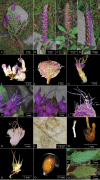Elsholtziazhongyangii (Lamiaceae), a new species from Sichuan, China
- PMID: 36760841
- PMCID: PMC9849022
- DOI: 10.3897/phytokeys.193.80327
Elsholtziazhongyangii (Lamiaceae), a new species from Sichuan, China
Abstract
Elsholtziazhongyangii (Lamiaceae), a new species from Sichuan Province, China, is described and illustrated. The new species is morphologically similar to E.feddeif.feddei, but it can be easily distinguished from E.feddeif.feddei by smaller corolla (3.2-3.5 mm vs. 4.5-5.3 mm), bract indumentum (glabrous, except margin ciliate vs. villous, especially on veins abaxially, glabrous adaxially) and bract stalked (ca. 1.2 mm vs. sessile). Phylogenetic analyses, based on two nuclear ribosomal (ETS, ITS) and five plastid (rbcL, matK, trnL-F, ycf1, ycf1-rps15) regions, confirmed that the new species formed a monophyletic clade with robust support. The new species is currently known from western Sichuan.
Keywords: Aromatic plant; Elsholtzieae; phylogeny; taxonomy; traditional medicinal herbs.
Xin-Jie Jin, Yue Huang, Yu-Kun Wei, Qing Ma, Lu-Xian Liu, Zhi-Xi Fu, Gui-Fang Wu, Yong-Hua Zhang, Pan Li.
Figures





References
-
- Editorial Board of Zhong Hua Ben Cao (1999) Lamiaceae. Zhong Hua Ben Cao, Shanghai Science and Technology Press, Shanghai, 19: 33–43.
-
- Harley RM, Atkins S, Budantsev A, Cantino PD, Conn BJ, Grayer R, Harley M. (2004) Labiatae. In: Kubitzki K, Kadereit JW (Eds) The Families and Genera of Vascular Plants, 7: 167–275. 10.1007/978-3-642-18617-2_11 - DOI
-
- Huang SC. (1977) Elsholtzia (Labiatae). In: Wu ZY, Li XW (Eds) Flora Reipublicae Popularis Sinicae, Science Press, Beijing, 66: 304–348. http://www.iplant.cn/info/Elsholtzia?t=foc
LinkOut - more resources
Full Text Sources
Miscellaneous
